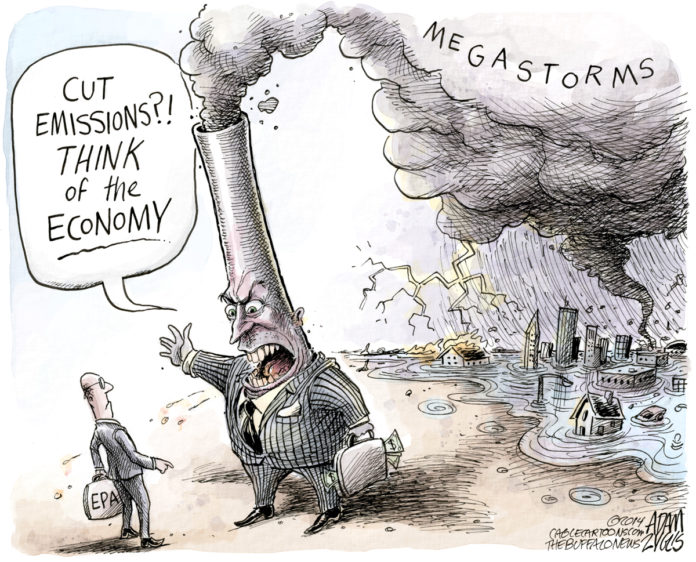Author’s Note: On Sunday, Sept. 21, at 2 p.m., Oklahomans are invited to participate in a People’s Climate March in downtown Oklahoma City. For more information visit http://act.350.org/event/peoples_climate/7783. This event, and hundreds of similar public events around the world, will call attention to the issue of climate change.
BY JAMES STOVALL
For those who grow weary of environmental alarmists, I want to put you at ease. This article is not about the evils of the oil industry. It not about EPA policy on climate change. It is not about a push for policies that will derail our fragile economy. While those are all important topics worthy of discussion and debate, this article is simply about a change in perspective; a change in how we view the earth.
The change in perspective starts with the notion that the earth is central to all human activity. There is no music or literature without the earth. There is no business, industry or technology without the earth. There is no sacred scripture without the earth. There are no babies without the earth. There is no stock market or GDP without the earth. The earth is that without which we have no future for our children and grandchildren. The earth cannot be replaced by technology or any type of scientific breakthrough.
To accept the premise that the earth is a central concern does not mean that you must change your religious beliefs. It does mean that we recognize the earth as a sacred gift from God. That doesn’t mean that we worship the earth as God. It does mean that we care deeply for this sacred gift above all other gifts. Our fate, as humans, is inextricably connected to the earth.
Humans are that part of the earth that seems to be uniquely able to celebrate and reflect upon the wonder of the whole of creation. The people of the 20th Century stumbled upon the fact humans are latecomers in what has been a journey of some 14 billion years of continuous creativity since the big bang. Discovering how this journey unfolded and understanding ourselves as part of this amazing process is one of the greatest accomplishments of human history.
For the second time in my lifetime, it appears that this creative process is seriously threatened. Humanity has approached the brink of extinction. The first time we faced such a grim reality was when nuclear war between the U.S. and the Soviet Union became a real possibility during the massive accumulation of nuclear weapons that took place in the decades following World War II.
As that threat has subsided, a new more insidious threat has emerged: climate change has become increasingly evident throughout the planet as one scientific report after another confirms what has been suspected for several decades.
Nuclear weapons first emerged onto the historical stage in July 1945 at the Trinity test site near Alamagordo, NM, as World War II was coming to a close. The first bombs to be dropped on human beings took place just weeks later in Hiroshima and Nagasaki, Japan. The world saw, for the first time, the incredible power that had been unleashed in these new “weapons” of war that had the capacity to kill hundreds of thousands instantly.
In the years that followed, the number and killing capacity of these weapons increased dramatically to the point that humanity had the force of 1.6 million Hiroshima bombs; an arsenal able to destroy the entire planet many times over.
In retrospect it is easy to question the logic behind the policy of what came to be known as “Mutually Assured Destruction.” The policy guided us into a scenario in which all life on the planet was threatened. The threat was no longer just losing a war to the Soviet Union but the new threat was the very real possibility that a nuclear war would mean the end of all civilization as we know it.
The more recent threat to life on the planet that emerged in the last century is climate change. Today the industrial system that was built with the best of intentions now threatens to end the very prosperity it sought to create. With climate change happening more quickly than anyone imagined, civilization has arrived at a critical decision point in which all of life as we know it, hangs in the balance.
In the case of the nuclear threat and in the case of climate change, there was and is a general lack of public awareness and significant response to what could be the greatest threat ever to humankind. Our collective failure to respond to the crisis in a significant way amounts to a kind of paralysis that must be overcome if we are to survive.
Too many feel totally helpless in the face of such a massive, global threat. Some respond with denial; pretending that the crisis doesn’t exist or minimizing the likely impact of the problem. Others respond with despair and hopelessness, believing that nothing can be done and that what little can be done isn’t nearly sufficient.
In the early days of science, we viewed ourselves as separate from the earth. This sense of detachment is what enabled us to probe the world. We were observers, so therefore we could explore the world and figure out how it worked. We could look into its physical, purely material, mechanistic parts and figure out how they worked. We could use that understanding as applied technology. Whether it was as simple as creating a wheel, or whether it was the kind of technology we’re shaping today, we can do what we’re doing only because of this sense of being separate and apart from the earth.
The whole evolution of Western history is marked by this ever-broadening and deepening knowledge of the physical energies of the universe and their application in technology. Today the assumption of humans as separate from the earth, no longer works.
Scientists today are increasingly recognizing that we are all in this journey together and that the destiny of humans is closely tied to the destiny of the earth. Every plant and creature is dependent upon the air, the soil and the water that we all share. These same scientists are pointing out that fundamental changes in our relationship to the earth must take place very soon if we are to avoid the disaster that climate change presents.
Life has a way of placing limits on our ability to control the future while at the same time driving us to care. In spite of the gloomy reality of climate change, a deep “yes” is being asked of us. People such as Gandhi, Churchill, King and Mandela all stood in that “yes” place to dare to declare their hopes and dreams; their confidence in the midst of “facts” that were telling them all was lost. Their presence of active hope made all the difference and the “impossible” happened.
Now it is our turn to choose active, engaged and strategic hope for the future. Human beings across the planet who are clear on our precarious situation must move through their despair and “roll up their sleeves.” Future generations require those concerned about the future to continue taking what are sometimes small but concrete steps to respond to the current crisis facing the planet.
As we face increasingly more chaotic times, we must continue to grow our capacity to respond in a resilient manner across all sections of humanity so that we will together be able to engender hope-filled action and compassion instead of fear and violence. And so we march.
– Jim Stovall, a father and grandfather, lives in Oklahoma City and is director at the Mediation Institute. He can be reached at j_stovall@site.net.








